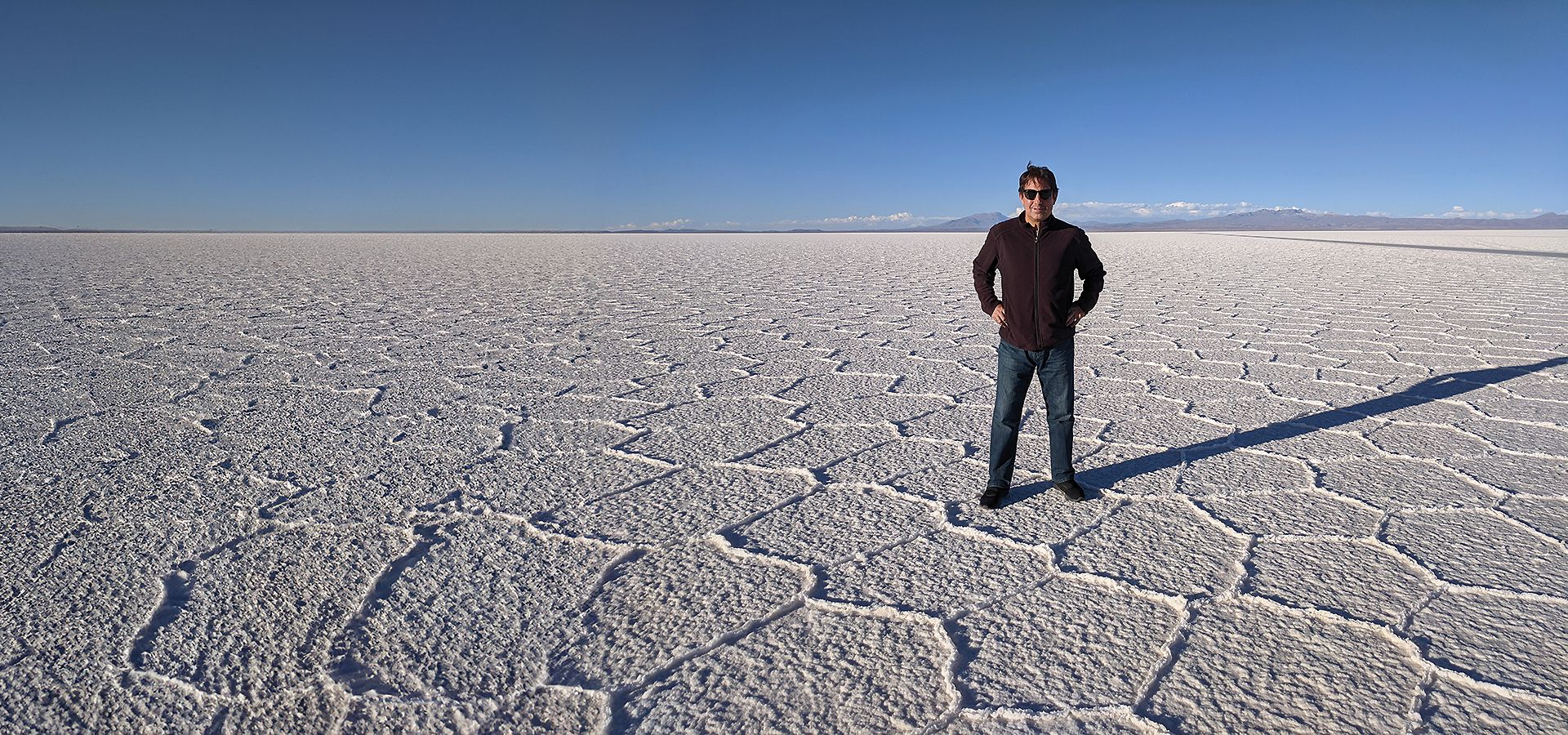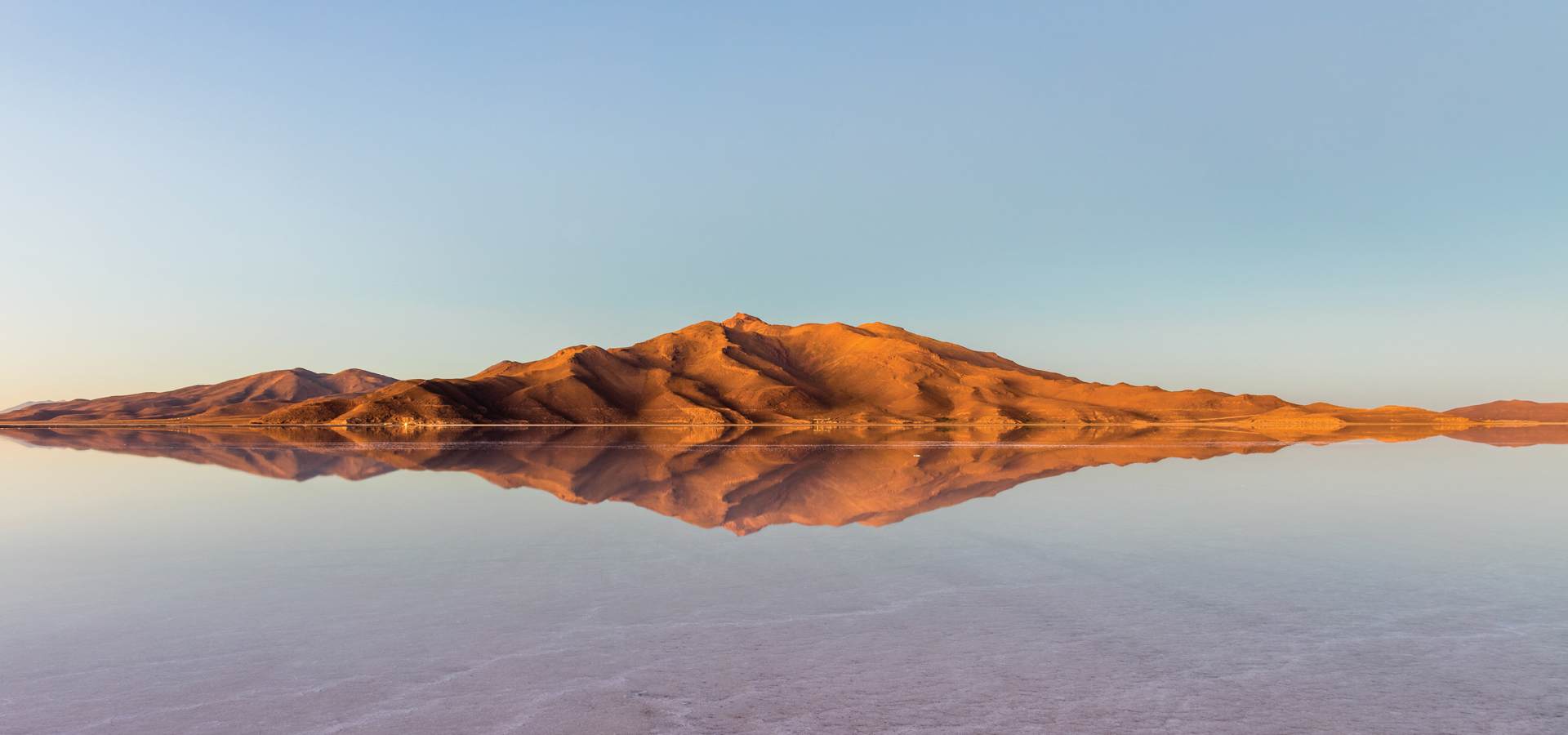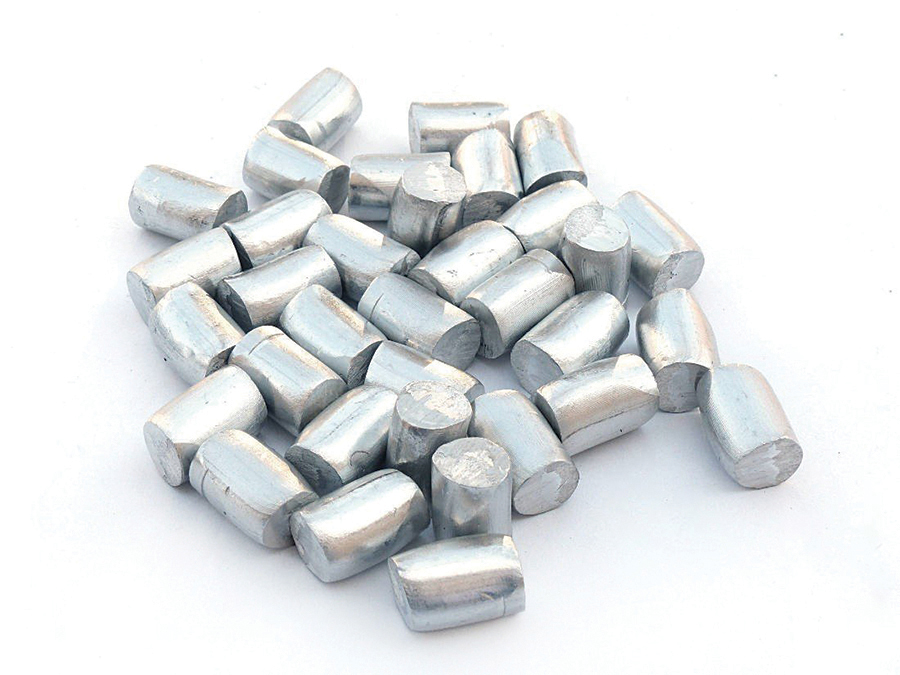Can Bolivia’s White Gold Power a Green Revolution?

Bolivia is home to the world’s largest deposits of lithium, arguably the most coveted component of a global clean energy transition. Diego von Vacano ’93 explains why capitalizing on it has proven so difficult.
In the southwest of Bolivia, after the rain stops but before the shallow floods disappear, the Salar de Uyuni goes from white plateau to a 4,000-square-mile mirror reflecting blue skies above. Even without precipitation, it’s a mesmerizing place—an endless, honeycombed salt flat high in the Andes that’s lured everyone from ecotourists to stargazers to the camera crews who filmed Star Wars: The Last Jedi. “You almost get the sense that you’re on a different planet,” says Diego von Vacano ’93, a Bolivian-born visitor to the salt flats since the 1980s. “Or on the moon.”
But lately, the Salar de Uyuni has drawn attention for what lies beneath: lithium, the rare-earth metal found in technologies ranging from smartphones to electric cars, and, as market-ready materials go, the most important square on the periodic table for a global green energy transition. Bolivia possesses 23 million metric tons of lithium, according to the U.S. Geological Survey—almost a quarter of all the lithium on Earth. Amidst growing global demand, von Vacano believes what’s colloquially called “white gold” could secure a new future for one of South America’s poorest countries—if Bolivia’s leaders can untangle the economic, technical, and political knots that are keeping most of it in the ground.
“Lithium is the only way to restructure Bolivia’s economy long term,” says von Vacano, a political science professor at Texas A&M University, one-time lithium policy advisor to current Bolivian president Luis Arce, and author of the forthcoming book Power over Energy: The Global Struggle for Lithium and the New Green Economy (Oxford University Press). “I think it’s the last chance for Bolivia to transform itself entirely.”

For centuries, Bolivia’s prosperity has been tied to its natural resources [see below]. “There’s always some particular commodity that’s central: silver, tin, the struggle over water and gas in the early 2000s,” says von Vacano, who lived in La Paz until the 1980 military coup of General Luis García Meza triggered his family to flee to the United States. The country’s abundance of lithium was common knowledge even before he and his sister Marcela von Vacano ’91 (now a lawyer for the U.S. Environmental Protection Agency) matriculated into Wesleyan in the late 1980s. “But at that time, this wasn’t really [seen] as anything potentially beneficial to Bolivia,” he says.
Today, as policymakers around the world look to technologies like EVs and battery storage to wean the world off fossil fuels, things are dramatically different. Global lithium demand tripled between 2017 and 2022, according to the International Energy Agency, and could grow tenfold by 2050. Chile and Argentina—which along with Bolivia form South America’s “lithium triangle,” home to more than half of the world’s known supply—have begun industrializing their resources. Chile, in fact, has become the world’s second-largest lithium producer, behind Australia.
But while Bolivian officials have talked about developing the country’s abundance of lithium since at least 2008, actually doing it has proven much more difficult. Despite hundreds of millions of dollars in investment, state-owned lithium company YLB has produced just a few thousand tons of lithium. (By comparison, Chile’s single-year production has topped 180,000 tons.) There are deep concerns about lithium mining’s ecological impacts and, since processing impurity-heavy brine into lithium carbonate has traditionally involved supersized evaporation ponds, its strain on the salt flats’ water resources. Meanwhile, Bolivia requires majority state ownership of lithium projects, and opening its resources to outside enterprise has proven politically polarizing: Some swear an agreement with a German lithium company (which was eventually rescinded) played a part in the revolt that forced three-term president Evo Morales into exile in late 2019.
As the country subsequently descended into the brief, brutal dictatorship of interim president Jeanine Áñez, von Vacano, who has a master’s degree in economic development, began thinking about lithium as a path to stability for his home country. He’d wanted to get involved in Bolivia’s public policy since his Wesleyan days, he says, and he was inspired by his visits to Texas A&M’s campus in Qatar: Over the span of a decade, he watched the small Middle Eastern monarchy use natural gas exports to spur a broad economic transformation. Given Bolivia’s history of resource extraction, he says, “I believed [lithium] was the only way for Bolivia to recover democracy after a year of the Jeanine Áñez government, and to try to recover the economic base since the natural gas sector”—Bolivia’s main cash cow ever since Morales decreed its nationalization in 2006—“was really declining.”
There are deep concerns about lithium mining’s ecological impacts and, since processing impurity-heavy brine into lithium carbonate has traditionally involved supersized evaporation ponds, its strain on the salt flats’ water resources.
He studied, made industry connections through colleagues in academia, and became an unpaid consultant for companies like the Texas-based start-up EnergyX, one of many developing higher-yield, lighter-footprint technologies collectively classified as direct lithium extraction (DLE). He reached out to entities in the United States, Russia, and the European Union, urging them to do business in Bolivia despite the country’s swings between credible elections and power grabs. Some showed interest, he says. “A lot of them didn’t. That’s when I started to meet more often with Luis Arce and his advisors.”
Von Vacano says he first built a rapport with Arce—Morales’s economy minister and handpicked candidate to represent the left-wing Mas political party in Bolivia’s 2020 presidential election—on the campaign trail, helping connect Bolivian students with scholarships and educational opportunities in America. “The more I met with Arce, I would always insist that lithium had the biggest potential to develop Bolivia,” he says, emphasizing that the landlocked country needed investment and technological capacity from foreign partners to capitalize on surging demand.
As Arce assumed the presidency and issued an open call for DLE proposals, von Vacano remained an unpaid lithium policy advisor, connecting Bolivian officials with company executives. And with the White House renewing its green energy commitments under President Biden, von Vacano saw lithium’s potential for thawing Bolivia’s frosty relationship with the U.S., which hasn’t had an ambassador to Bolivia since 2008—and, perhaps, developing a supply chain that didn’t depend on China, the world’s largest lithium processor and the long-running market leader in lithium-ion batteries. In 2021, von Vacano arranged meetings between Arce and Senator Bernie Sanders as well as with American economist Joseph Stiglitz, in which they discussed harnessing lithium to help Bolivia move beyond a resource-centered economy.
But von Vacano’s relationship with Arce soon soured. Von Vacano says he connected a New York Times reporter with sources for a story on EnergyX’s Bolivian lithium odyssey; upon the article’s publication, he says he encountered a “backlash” from the Arce administration, which bristled at what they saw as a depiction of its incompetence. As the war in Ukraine scrambled geopolitical alliances and Bolivia-U.S. relations grew tense once again, von Vacano grew increasingly concerned about unethical behavior within the rapidly closing ranks of the Arce administration. (Arce’s son has since come under investigation for his role in Bolivia’s lithium negotiations.) After von Vacano published an opinion piece in Bolivian media criticizing the regime’s lack of transparency, the Arce administration denied its connections with him.
“I think Arce’s major focus was how he can keep political power for the next election cycle, and he wasn’t really thinking about a long-term economic strategy for the country,” he says. “He had promised to be a more technocratic, more cosmopolitan leader, but in fact tried to become a caudillo—or a strongman—himself.”
Today, von Vacano is in the midst of writing Power over Energy, a book weaving together Bolivia’s history of left- and right-wing populist strongmen, its Marxist political traditions, the wider world’s geopolitical interests in Latin America’s natural resources, and his own experiences to convey the breadth of his home country’s fitful journey toward lithium development. “People think about it in a purely technical way, or they think about the economics of it, but for something like this to actually work in Bolivia, it involves a lot of different fields: culture, history, internal and external politics, international relations,” says von Vacano, who was awarded a prestigious fellowship from the Wilson Center to finish the book. “I wasn’t aware of how complex it was until I got involved.”
Besides those complexities, the future of Bolivian lithium is rife with uncertainty. Arce was expelled from the Mas party last year and faces a potential electoral challenge from Morales, now a bitter rival, in 2025. Though the country has celebrated big-money agreements with Chinese and Russian entities—one of which began constructing an industrial-sized lithium facility near the Salar de Uyuni in December 2023—these aren’t contracts: Bolivian lawmakers have yet to approve a legal framework for private companies to extract the country’s lithium.
But if lithium production remains little more than a dream stuck inn the ground, it’s not hard to imagine social and political unrest surfacing once again.
There are other potential headwinds, from attempts at building green batteries from easier-to-source materials like sodium, to a looming expansion of lithium mines in the American West, to the discovery of a caldera on the Nevada-Oregon border that some speculate could contain nearly twice as much lithium as all of Bolivia. And while lithium prices soared to an all-time high of $80,000 per metric ton in 2022, slowing Chinese demand, pain points in EV adoption, and a global lithium surplus sent the price plummeting to $13,000 per ton in January 2024, a three-year low.
Though Bolivia missed out on this earlier bonanza, experts expect a recovery in the market before the end of the decade. In theory, that would give the country enough time to build commercial-scale facilities and infrastructure to satisfy demand as existing supplies of lithium diminish, von Vacano says. But if lithium production remains little more than a dream stuck in the ground, it’s not hard to imagine social and political unrest surfacing once again.
“Unfortunately, Bolivia has this cycle of things coming back,” he says. “I think this is the last chance to come out of this cycle.
Bolivia’s Natural Resources: A Partial History
Silver
From the 16th century through Bolivia’s liberation in 1825, the Spanish Empire gained world-historic wealth and changed global trade because of the silver beneath the city of Potosí. Carried out by slaves and Indigenous peoples, silver mining proved extraordinarily perilous, with tunnel collapses, respiratory disease, and other hazards causing millions of deaths.

Tin
Tin became Bolivia’s main export by the early 20th century, enriching a trio of tin barons—Carlos Aramayo, Moritz Hochschild, and Simón Patiño—who held outsized political influence and exploited miners. Tin miners became a driving force for the National Revolution of 1952, which led to land reforms, social programs, and the nationalization of the mining sector.

Water
The privatization of Bolivia’s water—a condition for an International Monetary Fund loan to stimulate the country’s economy in the late 1990s—sparked a popular uprising in the city of Cochabamba in 2000 called “la guerra del agua,” or the water war. The privatization plan was ultimately rescinded.

Cocaine
Coca leaves—an Indigenous medicine since the Inca Empire—grew into a high-value cash crop as America’s appetite for cocaine began surging in the 1970s. In 1980, cocaine cartels financed a right-wing coup by General Luis García Meza, who massacred political opponents and was eventually convicted of genocide.

Natural Gas
In 2003, President Gonzalo Sánchez de Lozada attempted to privatize and export natural gas through Chile, provoking a six-week mass protest that drew participation from one in seven Bolivians as well as a military crackdown that killed at least 59 civilians. In the aftermath, Sánchez de Lozada resigned, Evo Morales—who came to prominence during the gas conflicts—was elected Bolivia’s first Indigenous president in 2005, and the country later nationalized its natural gas resources.




